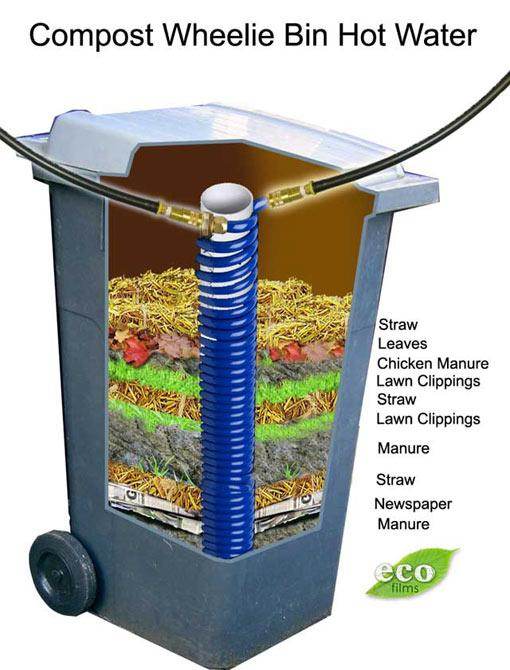
 2
2




My books, movies, videos, podcasts, events ... the big collection of paul wheaton stuff!




My books, movies, videos, podcasts, events ... the big collection of paul wheaton stuff!





Ask me about food.
How Permies.com Works (lots of useful links)





My books, movies, videos, podcasts, events ... the big collection of paul wheaton stuff!











Feedstocks: Bark Mulch, Wood Chips, Sawdust,
We believe a variety of feedstock-materials can be used to generate significant heat. Controlled tests are being conducted through UVM and other demonstration-sites to document the temperature and longevity of various combinations of mulch, chips, sawdust, manure and other compost-process materials. Some materials or mixtures may run hotter but for shorter periods of time. Hard wood materials may provide more heat than soft materials but soft woods may heat for longer periods.
It’s important for at least some of the material to be shredded or small-diameter wood-chips to provide enough surface area for the bacteria and air to reach the material and build critical mass of activity (heat).
A mound made of wood-chips alone will produce 95 to 110 degree water for in the spring/summer/fall but will cool off in the winter. Shredded bark-mulch works very well and should provide 110 to 140 degree water as long as it’s fresh and has not been contaminated with industrial lubricants. Rot-resistant feeds-stocks like cedar, hemlock or black locust will not produce heat and are to be absolutely avoided. Pine is ok in small proportions but not recommended as the primary feedstock. Fresh double ground barks will provide about the right particle size for most projects but wood-chips mixed with sawdust and/or manure will also work. The quality of the feedstock and the aeration of the system are the main factors determining the amount of heat produced and the value of the compost after you stop collecting heat from it.
Ask me about food.
How Permies.com Works (lots of useful links)





 2
2




My books, movies, videos, podcasts, events ... the big collection of paul wheaton stuff!
 1
1








My books, movies, videos, podcasts, events ... the big collection of paul wheaton stuff!
 1
1




 1
1








Small Sustainable housing: Tiny Houses, Tiny Living: TheTinyLife.com




 1
1




My books, movies, videos, podcasts, events ... the big collection of paul wheaton stuff!




paul wheaton wrote:Oh right! We do have about a bunch of spent grain from a brewery at the bottom of the pile. From a permaculture-savvy brewery in the bitterroot: Wildwood Brewery.
 1
1
















Daniel Weeber wrote:I'm tempted to build one of these. Where I live, a lot of people have horses, but they also don't really want the horse manure. It's pretty easy to pick up two truckloads of manure in less than an hour. Anyone see a problem in using horse manure for this setup?
 6
6




Co creator at Inspiration Farm
http://www.inspirationfarm.com/
Workshops, Tours, Internships
Be the change you want to see in the world




 1
1




 1
1




During our twice-yearly on-farm PDCs we have over 30 people at our farm for 2 weeks straight, all using this system exclusively for their showers. While I’m not sure everyone chooses to shower every day, many do and the system holds up under the enthusiastic strain. A pretty good recommendation, i think.
 1
1





It's time to get positive about negative thinking  -Art Donnelly
-Art Donnelly












Brian Kerkvliet wrote:
7- You need to ask yourselves what are your goals for using compost to heat water? Is it for the compost? Is it for the novelty? Do you have too much biomass? Do you want to use this as an avenue to do experiments? Or do you want to clean up the stinky permis? All of the answers to these questions will lead you to the right approaches to take.
 1
1




Beautiful Nazareth Farms farm site
This Happy Homestead homestead blog




"The world is changed by your example, not your opinion." ~ Paulo Coelho




Same here.Heather Staas wrote:
Fascinating. More research needed.. off to follow the links and websites in this thread...




Moderator, Treatment Free Beekeepers group on Facebook.
https://www.facebook.com/groups/treatmentfreebeekeepers/





 2
2





If no one from the future comes to stop you is it really that bad of a decision?
 2
2




Nerds be nerding...








 1
1




Nerds be nerding...
 2
2




Every day, every season there is change, something new to observe, and constant learning. Permaculture has the dimensions of a life-oriented chess game, involving the elements, energy, and the dimensions of both life-forms and building structures (also with political, social, financial, and global implications).











Ask me about food.
How Permies.com Works (lots of useful links)





My books, movies, videos, podcasts, events ... the big collection of paul wheaton stuff!

|
Put the moon back where you found it! We need it for tides and poetry and stuff. Like this tiny ad:
A rocket mass heater heats your home with one tenth the wood of a conventional wood stove
http://woodheat.net
|




